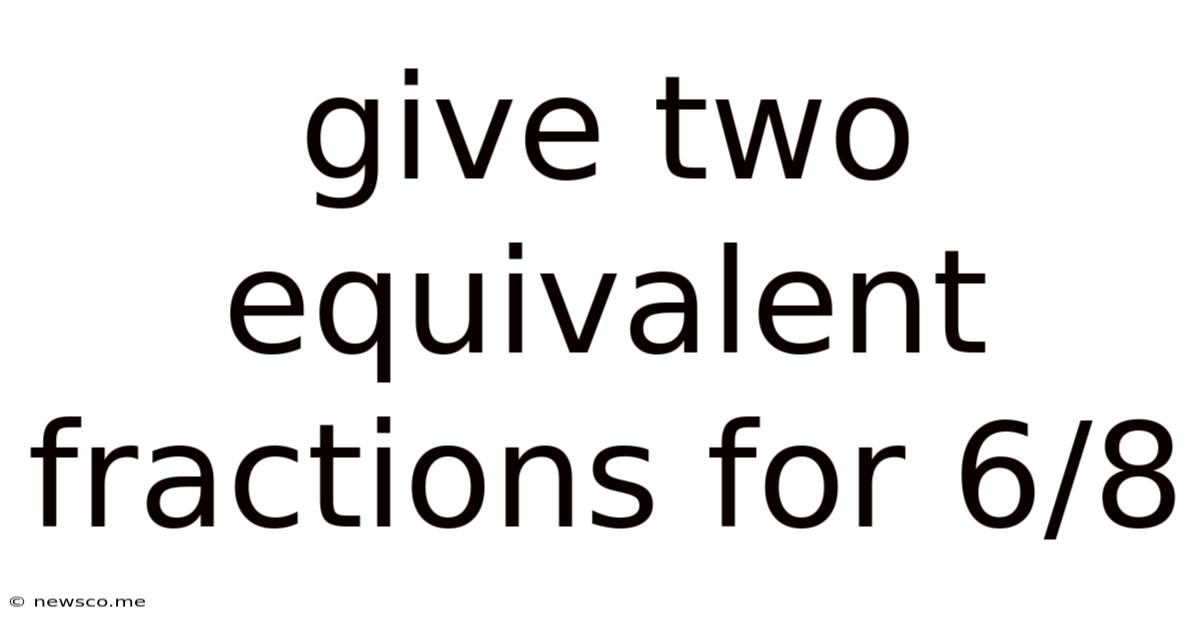Give Two Equivalent Fractions For 6/8
News Co
Mar 30, 2025 · 5 min read

Table of Contents
Give Two Equivalent Fractions for 6/8: A Deep Dive into Fraction Equivalence
Finding equivalent fractions is a fundamental concept in mathematics, crucial for understanding ratios, proportions, and various other mathematical operations. This article explores the concept of equivalent fractions, focusing on finding two equivalent fractions for 6/8. We’ll delve into the underlying principles, explore different methods to find equivalent fractions, and illustrate their applications in real-world scenarios. We’ll also cover advanced topics related to simplifying fractions and the significance of equivalent fractions in higher-level mathematics.
Understanding Equivalent Fractions
Equivalent fractions represent the same portion or value, even though they are written differently. They share the same proportional relationship between their numerators (the top number) and denominators (the bottom number). Imagine slicing a pizza: 6/8 of a pizza is the same as 3/4 of a pizza – both represent the same amount. The key to understanding equivalent fractions lies in the concept of multiplying or dividing both the numerator and denominator by the same non-zero number. This maintains the proportion and results in an equivalent fraction.
The Fundamental Principle of Equivalent Fractions
The core principle behind equivalent fractions is that multiplying or dividing both the numerator and the denominator by the same non-zero number does not change the value of the fraction. This is because you're essentially multiplying or dividing by 1, disguised as a fraction (e.g., 2/2 = 1, 3/3 = 1, etc.).
Finding Two Equivalent Fractions for 6/8
Let's find two equivalent fractions for 6/8. We can achieve this through two primary methods:
Method 1: Simplifying (Reducing) the Fraction
The simplest approach to finding an equivalent fraction is to simplify the given fraction to its lowest terms. This involves finding the greatest common divisor (GCD) of the numerator and the denominator and dividing both by it.
The GCD of 6 and 8 is 2. Dividing both the numerator and denominator by 2, we get:
6 ÷ 2 / 8 ÷ 2 = 3/4
Therefore, 3/4 is one equivalent fraction of 6/8. It's the simplified form, meaning there is no common divisor greater than 1 for the numerator and denominator.
Method 2: Multiplying the Numerator and Denominator
To find another equivalent fraction, we can multiply both the numerator and denominator by the same number (any non-zero whole number). Let's multiply by 2:
(6 × 2) / (8 × 2) = 12/16
Thus, 12/16 is another equivalent fraction of 6/8.
More Examples of Finding Equivalent Fractions
Let's explore some more examples to solidify the understanding of this concept.
Example 1: Find two equivalent fractions for 2/5.
- Simplifying: 2/5 is already in its simplest form, as the GCD of 2 and 5 is 1.
- Multiplying: Multiplying both the numerator and denominator by 2 gives us 4/10. Multiplying by 3 gives 6/15. Both 4/10 and 6/15 are equivalent to 2/5.
Example 2: Find two equivalent fractions for 15/25.
- Simplifying: The GCD of 15 and 25 is 5. Dividing both by 5 gives 3/5.
- Multiplying: Multiplying 3/5 by 2 gives 6/10. Multiplying by 4 gives 12/20. Both 6/10 and 12/20 are equivalent to 15/25 and 3/5.
Example 3: Find two equivalent fractions for 12/18.
- Simplifying: The GCD of 12 and 18 is 6. Dividing both by 6 gives 2/3.
- Multiplying: Multiplying 2/3 by 5 gives 10/15. Multiplying by 7 gives 14/21. Both 10/15 and 14/21 are equivalent to 12/18 and 2/3.
Applications of Equivalent Fractions
Equivalent fractions are not just a theoretical concept; they have numerous practical applications across various fields:
-
Cooking & Baking: Recipes often require adjusting ingredient amounts. Understanding equivalent fractions allows for accurate scaling of recipes. For example, if a recipe calls for 1/2 cup of sugar and you want to double the recipe, you’d need 2/4 cups (or 1 cup) of sugar.
-
Construction & Engineering: Accurate measurements are critical in construction. Equivalent fractions help in converting measurements from one unit to another (e.g., inches to feet).
-
Financial Calculations: Working with percentages and proportions in finance requires a thorough understanding of equivalent fractions. For instance, calculating discounts or interest rates involves expressing fractions in different, equivalent forms.
-
Data Analysis & Statistics: Presenting data often involves working with fractions and proportions. Equivalent fractions help in simplifying complex data and making it more easily understandable.
Advanced Topics: Simplifying Fractions and Continued Fractions
Simplifying Fractions: Simplifying a fraction to its lowest terms is important for several reasons:
- Ease of understanding: Simpler fractions are easier to grasp and compare.
- Efficiency in calculations: Working with simplified fractions makes calculations quicker and less error-prone.
- Standardization: Simplifying fractions ensures a consistent representation of a given value.
Continued Fractions: Equivalent fractions can lead to a fascinating area of mathematics called continued fractions. A continued fraction is an expression of a number as a sum of a whole number and the reciprocal of another whole number and the reciprocal of another whole number, and so on. This concept has applications in number theory and approximation theory.
Conclusion
Understanding and working with equivalent fractions is a cornerstone of mathematical literacy. This article illustrated several techniques for finding equivalent fractions, highlighting the importance of simplifying fractions and the wide-ranging applications of this crucial mathematical concept in diverse fields. Whether you're a student, a professional, or simply curious about mathematics, mastering equivalent fractions will enhance your mathematical abilities and problem-solving skills. The examples provided serve as a solid foundation for deeper exploration of fractional arithmetic and related mathematical concepts. Remember, the ability to confidently manipulate fractions is essential for success in various mathematical endeavors.
Latest Posts
Related Post
Thank you for visiting our website which covers about Give Two Equivalent Fractions For 6/8 . We hope the information provided has been useful to you. Feel free to contact us if you have any questions or need further assistance. See you next time and don't miss to bookmark.